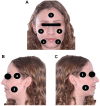Olfactory and Oral Manifestations of COVID-19: Sex-Related Symptoms-A Potential Pathway to Early Diagnosis
- PMID: 32539587
- PMCID: PMC7298562
- DOI: 10.1177/0194599820934380
Olfactory and Oral Manifestations of COVID-19: Sex-Related Symptoms-A Potential Pathway to Early Diagnosis
Abstract
Objective: The coronavirus disease 2019 (COVID-19) pandemic poses a threat to global health. Early diagnosis is an essential key to limit the outbreak of the virus.
Study design: Case series, study conducted between March 25, 2020, and April 15, 2020.
Setting: Ambulatory, nonhospitalized patients who were quarantined in a designated hotel for COVID-19 patients and were recruited by an advertisement at the hotel.
Subjects and methods: In total, 140 patients participated in a web-based questionnaire assessing initial symptoms of common viral diseases, olfactory and taste functions, xerostomia, and orofacial pain.
Results: A total of 58 men and 70 women participated. Initial symptoms were cough (59.4%), weakness (47.7%), myalgia (46.9%), fever (42.2%), headache (40.6%), impaired sense of smell (38.3%), impaired sense of taste (32.8%), sore throat (26.6%), runny nose (26.6%), and nasal congestion (22.7%). All symptoms were more frequent among women; however, only runny nose was statistically significant (P = .018). The most common combination of symptoms was cough and weakness (37.5%). A total of 25.8% reported olfactory and taste dysfunctions in the absence of other symptoms. In a comparison between the sexes, cough and runny nose were the most common combination in women (P = .018). A total of 38.3% of patients reported olfactory dysfunction as an initial symptom. Anosmia and facial pain were more common among women (P < .001 and P = .01, respectively), and 56% of patients reported xerostomia.
Conclusion: A considerable number of patients presented with olfactory and oral disorders. Interestingly, women presented with a different cluster of symptoms than men, which may suggest a new clinical approach to diagnosing COVID-19 disease.
Keywords: COVID-19; anosmia; coronavirus; dysgeusia; xerostomia.
Conflict of interest statement
Figures



Comment in
-
Commentary on Letter to the Editor regarding "Eight-month follow-up of olfactory and gustatory dysfunction in recovered COVID-19 patients".Am J Otolaryngol. 2021 Nov-Dec;42(6):103190. doi: 10.1016/j.amjoto.2021.103190. Epub 2021 Sep 2. Am J Otolaryngol. 2021. PMID: 34488185 Free PMC article. No abstract available.
References
MeSH terms
LinkOut - more resources
Full Text Sources
Medical
Miscellaneous

